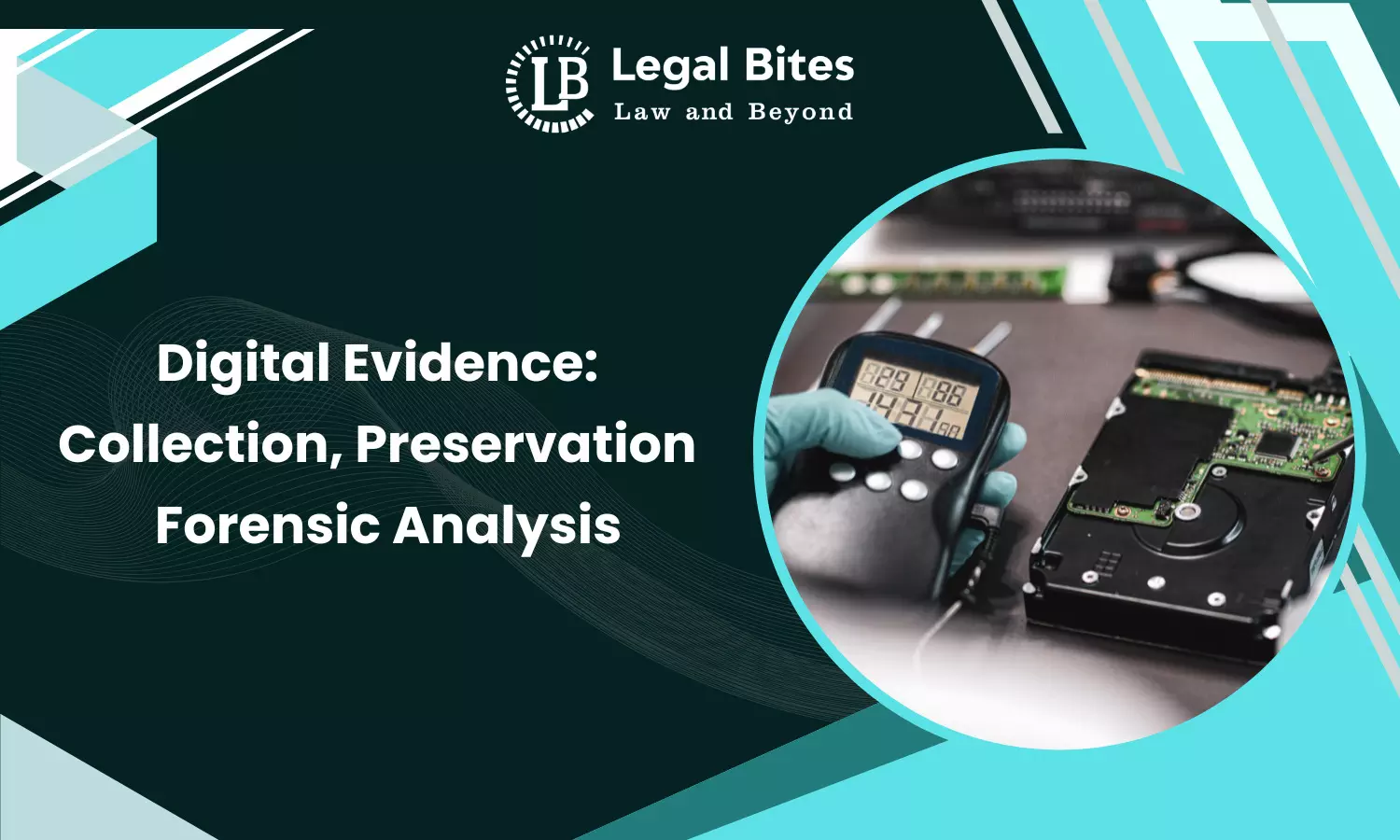Digital Evidence: Collection, Preservation and Forensic Analysis
Forensic law sets protocols to accurately collect, preserve, and analyze digital evidence, ensuring its court admissibility.

In the digital age, evidence extends beyond physical traces to encompass a vast array of electronic data. Digital evidence plays a crucial role in modern investigations, ranging from cybercrimes to financial frauds, intellectual property theft, and even violent crimes. Forensic law has developed specialized protocols and methodologies to ensure the accurate collection, preservation, and analysis of digital evidence, ensuring its admissibility in court.
This article explores the legal framework and best practices in the collection, preservation, and analysis of digital evidence, emphasizing the importance of following forensic standards to maintain its integrity.
Digital Evidence: An Overview
Digital evidence refers to any information or data stored or transmitted in digital form that can be used in legal proceedings. This evidence may come from various sources, including:
- Computers: Hard drives, files, and system logs.
- Mobile devices: Text messages, call logs, apps, and GPS data.
- Network data: Logs from internet service providers, emails, and social media communications.
- Internet of Things (IoT): Data from smart devices such as cameras, wearables, and smart home systems.
- Given its nature, digital evidence is fragile and can be easily modified, deleted, or corrupted if not handled properly. Therefore, it is essential to follow established forensic protocols during its collection and analysis.
Legal Framework Governing Digital Evidence
The legal standards for digital evidence are crucial to ensure its admissibility in court. In India, the Information Technology Act, 2000, and its amendments provide a foundation for handling digital evidence. The Bharatiya Sakshya Adhiniyam, 1872, amended by the IT Act, includes provisions for recognizing electronic records as admissible evidence under Sections 65A and 65B.
Section 65B outlines the procedure for the admissibility of electronic records, requiring certification that the evidence is authentic and unaltered. It ensures that digital evidence meets the legal criteria of relevance, reliability, and integrity. Courts have also established precedents regarding the admissibility of digital evidence, such as in the cases of Anvar P.V. v. P.K. Basheer (2014) and Arjun Panditrao Khotkar v. Kailash Kushanrao Gorantyal (2020), which further refine the application of Section 65B.
Collection of Digital Evidence
The collection of digital evidence must be conducted systematically to prevent contamination or alteration. The process involves several key steps:
a) Preparation
Investigators must prepare by obtaining the necessary legal authorizations, such as search warrants, and ensuring they have the appropriate tools and expertise. Proper preparation also includes documenting the environment and creating a chain of custody to track who accesses the evidence and when.
b) Acquisition
Digital evidence acquisition involves extracting data from electronic devices. This must be done in a manner that preserves the original data, often using forensic tools such as EnCase, FTK (Forensic Toolkit), or XRY. Forensic imaging—creating a bit-by-bit copy of the device’s storage—is a standard practice to ensure that the original data remains unaltered.
c) Documentation
Documentation is critical during evidence collection. Investigators must record every action taken, including the tools used, the time, and the condition of the device. This information helps establish the authenticity and integrity of the evidence.
d) Maintaining Chain of Custody
The chain of custody is a documented record that traces the evidence from the time it is collected until it is presented in court. Each transfer of the evidence must be documented to demonstrate that it has not been tampered with. A well-maintained chain of custody is crucial for the admissibility of digital evidence in court.
Preservation of Digital Evidence
Preserving digital evidence involves maintaining its integrity from the moment it is collected until it is presented in legal proceedings. Key principles include:
a) Imaging and Hashing
To preserve evidence, forensic investigators create a forensic image of the digital media. This image is an exact bit-by-bit copy of the original, which allows analysis without altering the original data. Hashing algorithms (e.g., MD5, SHA-256) are used to generate a unique hash value for the original data and the forensic image. Any alteration in the data will change the hash value, helping investigators verify the integrity of the evidence throughout the investigation.
b) Secure Storage
Digital evidence should be stored securely in a controlled environment. Access to the storage area must be limited and monitored, and evidence should be stored using encrypted methods to protect it from unauthorized access. Backup copies are also recommended to prevent data loss.
c) Compliance with Legal Standards
Ensuring compliance with relevant legal standards, such as those outlined in ISO/IEC 27037, which provides guidelines for identifying, collecting, acquiring, and preserving digital evidence, is vital. Compliance ensures that the evidence remains admissible and credible.
Analysis of Digital Evidence
The analysis of digital evidence must be conducted methodically to uncover relevant information without altering the data. Key aspects include:
a) Forensic Analysis Tools
Forensic experts use specialized software tools like Autopsy, Sleuth Kit, FTK, and EnCase to analyze digital evidence. These tools allow for the examination of files, recovery of deleted data, and extraction of metadata that may provide information about the origin, timeline, and usage of digital files.
b) Network Forensics
In cases involving cybercrime, network forensics plays a critical role. It involves analyzing network traffic and logs to trace unauthorized access or data breaches. Tools like Wireshark and NetFlow help experts capture and analyze network data, identifying suspicious activities.
c) Mobile Forensics
With the prevalence of mobile devices, mobile forensics has become increasingly important. Techniques such as SIM cloning, extraction of deleted SMS, call logs, and app data are used to recover information from mobile phones. Software like XRY and Cellebrite facilitate this process, ensuring the evidence is collected in a legally acceptable manner.
d) Analysis of Cloud Data
Cloud storage presents unique challenges due to its decentralized nature. Investigators must collaborate with cloud service providers and ensure they have the legal authority to access data stored on remote servers. The analysis of cloud data often involves reviewing access logs and account activities to trace unauthorized or suspicious behaviour.
Challenges in Digital Evidence Handling
Despite advancements in forensic technology, several challenges persist:
a) Encryption and Anti-Forensics
Encryption is widely used to protect data, posing a challenge for forensic investigators. Breaking encryption without the proper keys may be time-consuming or even impossible. Similarly, anti-forensic techniques, such as data-wiping tools, can be used to delete or obfuscate evidence.
b) Rapid Technological Advancements
The fast-paced evolution of technology means that forensic techniques must continually evolve. New operating systems, software applications, and devices often require updated methods for evidence extraction and analysis.
c) Jurisdictional Issues
Digital evidence often involves data stored across multiple jurisdictions, especially in cases involving cloud services. Investigators must navigate legal barriers and international laws to access evidence stored in different countries, which can complicate investigations.
Conclusion
Digital evidence is a powerful tool in modern legal proceedings, but it requires careful handling to maintain its integrity and admissibility. By adhering to established forensic protocols for evidence collection, preservation, and analysis, and by staying updated with technological advancements and legal developments, forensic investigators can effectively support the justice system. Legal professionals must also be familiar with the complexities of digital evidence to present it effectively in court, ensuring that justice is served.
References
[1] Information Technology Act, 2000
[2] Bharatiya Sakshya Adhiniyam, 2023
[3] Anvar P.V. v. P.K. Basheer, (2014) 10 SCC 473
[4] Arjun Panditrao Khotkar v. Kailash Kushanrao Gorantyal, (2020) 7 SCC 1
[5] Information Technology — Security Techniques — Guidelines for Identification, Collection, Acquisition, and Preservation of Digital Evidence, Available Here

Apurva Neel
I am a Research Associate and Editor at Legal Bites with an LL.M. specialization in Corporate and Commercial Laws from Amity University, Mumbai. I have put my best efforts into presenting socio-legal aspects of society through various seminars, conferences etc. I keep refining content as I am an ardent writer, and palpably law has got multi-dimensional aspect, so I passionately try to explore ahead.
